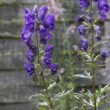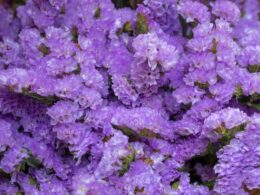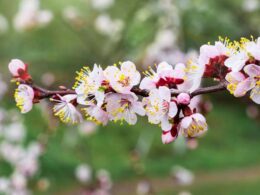The Two Species of Clover Flowers
Clover flowers come in two basic species: the red clover (Trifolium pratense) and the white clover (Trifolium repens). As their names suggest, red clovers have reddish-purple flowers while white clovers have small, white flowers. Both clovers are perennial plants, which means they live for more than two years.
Red clovers are native to Europe, Western Asia, and northwest Africa. Meanwhile, white clovers are from Europe and Central Asia. Both species have been introduced worldwide as forage or fodder crops. Today, you can also find them in North America, South America, Australia, and New Zealand.
How Are They Different Besides Their Color?
The flowers of both clover species grow in clusters at the end of stems, but red clovers can grow 8-31 inches tall, while white clovers are low-growing, and typically won’t exceed 8 inches in height. Sometimes, an odd plant of the red clover species will have white flowers – don’t let that fool you!
Red clovers have slightly pointed leaves that are arranged in groups of three. Each leaflet is around 15-30 mm (0.6-1.2 in) long and has a V-shaped mark on the top surface. On the other hand, white clovers have oval leaves which are light green and smaller than red clover leaves.
The Traditional Uses of Clover Flowers
Red clover flowers and leaves have been used for centuries in traditional medicine. Tea made from its flower heads is thought to help with respiratory problems like bronchitis and asthma. It’s also believed to act as a mild sedative.
Red clover tea is also taken as a supplement for its high levels of coumestrol. Coumestrol is a type of phytoestrogen, which is a plant compound that has estrogen-like effects in the body. This property has made red clover tea a popular supplement for menopausal women.
White clovers, on the other hand, have been used in India against intestinal worms. One experimental study confirmed that the aerial shoots of this plant have anti-tapeworm properties.
However, the broader medicinal properties of clover flowers are still being studied, and more research is needed to determine its effectiveness. If you’re interested in trying clover tea, be sure to consult with your healthcare provider first.
The Culinary Uses of Clover Flowers
If you’re feeling adventurous, clover flowers can also be used in cooking. White clover flowers are edible and can be added to salads for a pop of color. They can also be smoked as a herbal alternative to tobacco.
Meanwhile, red clover flowers can be used to make jelly and tisanes. The flower heads can also be added to any dish as garnishes or dried and ground into a powder that can be used as a flour substitute.
Fun Facts About Red Clovers
Looking for more interesting facts about clovers? Here’s our selection of things you may have never heard about them.
- The red clover (Trifolium pratense) is one of the national flowers of Denmark, alongside the daisy. It was declared so in 1936, although the daisy is more widely recognized.
- It’s also been the state flower of Vermont since 1895.
- The economic stability of Chile depends largely on red clovers because of their use as animal fodder.
Fun Facts About White Clovers
The white clover isn’t boring, either. Here are some fun facts about it.
- In Ireland, the shamrock – which is actually a white clover plant – is a symbol of good luck. Legend has it that Saint Patrick used the shamrock to explain the Holy Trinity to the Irish people.
- The white clover is an important source of nectar for bees. In fact, clover honey is a type of honey made from the nectar of clover flowers.
- Their Latin name, Trifolium repens, literally means ‘creeping three-leaf.’ This refers to their stems, which are known to creep 7 about inches in a year.
Will You Look Differently at Clover Flowers Now?
Whether you consider clovers weeds or not, they’re actually quite interesting plants with a long history. Who knows, you may even decide to grow a clover meadow!



















